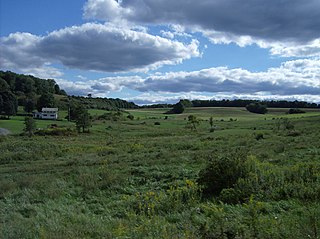United States v. Place, 462 U.S. 696 (1983), is a decision by the Supreme Court of the United States in which the Court held that it does not violate the Fourth Amendment to the U.S. Constitution for a trained police dog to sniff of a person's luggage or property in a public place.

The open-fields doctrine, in the U.S. law of criminal procedure, is the legal doctrine that a "warrantless search of the area outside a property owner's curtilage" does not violate the Fourth Amendment to the United States Constitution. However, "unless there is some other legal basis for the search," such a search "must exclude the home and any adjoining land that is within an enclosure or otherwise protected from public scrutiny."
United States v. Verdugo-Urquidez, 494 U.S. 259 (1990), was a United States Supreme Court decision that determined that Fourth Amendment protections do not apply to searches and seizures by United States agents of property owned by a nonresident alien in a foreign country.
California v. Greenwood, 486 U.S. 35 (1988), was a case in which the Supreme Court of the United States held that the Fourth Amendment does not prohibit the warrantless search and seizure of garbage left for collection outside the curtilage of a home.

Board of Education, Island Trees Union Free School District No. 26 v. Pico, 457 U.S. 853 (1982), was a case in which the United States Supreme Court split on the First Amendment issue of local school boards removing library books from junior high schools and high schools. Four Justices ruled that it was unconstitutional, four Justices concluded the contrary, and one Justice concluded that the court need not decide the question on the merits. Pico was the first Supreme Court case to consider the right to receive information in a library setting under the First Amendment, but the court's fractured plurality decision left the scope of this right unclear.
County of Allegheny v. American Civil Liberties Union, 492 U.S. 573 (1989), was a United States Supreme Court case in which the Court considered the constitutionality of two recurring Christmas and Hanukkah holiday displays located on public property in downtown Pittsburgh. The first, a nativity scene (crèche), was placed on the grand staircase of the Allegheny County Courthouse. The second of the holiday display in question was an 18-foot (5.5 m) public Hanukkah menorah, which was placed just outside the City-County Building next to the city's 45-foot (14 m) decorated Christmas tree and a sign saluting liberty. The legality of the Christmas tree display was not considered in this case.
In United States constitutional law, expectation of privacy is a legal test which is crucial in defining the scope of the applicability of the privacy protections of the Fourth Amendment to the U.S. Constitution. It is related to, but is not the same as, a right to privacy, a much broader concept which is found in many legal systems. Overall, expectations of privacy can be subjective or objective.
United States v. Montoya De Hernandez, 473 U.S. 531 (1985), was a U.S. Supreme Court case regarding the Fourth Amendment's border search exception and balloon swallowing.
Florida v. Bostick, 501 U.S. 429 (1991), was a United States Supreme Court case that overturned a per se rule imposed by the Florida Supreme Court that held consensual searches of passengers on buses were always unreasonable. The Court ruled that the fact that the search takes place on a bus is one factor in determining whether a suspect feels free to decline the search and walk away from the officers.
California v. Ciraolo, 476 U.S. 207 (1986), was a decision by the Supreme Court of the United States in which the Court held that aerial observation of a person's backyard by police, even if done without a search warrant, does not violate the Fourth Amendment to the U.S. Constitution.
Apodaca v. Oregon, 406 U.S. 404 (1972), was a United States Supreme Court case in which the Court held that state juries may convict a defendant by a less-than-unanimous verdict in a felony criminal case. The four-justice plurality opinion of the court, written by Justice White, affirmed the judgment of the Oregon Court of Appeals and held that there was no constitutional right to a unanimous verdict. Although federal law requires federal juries to reach criminal verdicts unanimously, the Court held Oregon's practice did not violate the Sixth Amendment right to trial by jury and so allowed it to continue. In Johnson v. Louisiana, a case decided on the same day, the Court held that Louisiana's similar practice of allowing criminal convictions by a jury vote of 9–3 did not violate due process or equal protection under the Fourteenth Amendment.
United States v. Martinez-Fuerte, 428 U.S. 543 (1976), was a decision of the United States Supreme Court that allowed the United States Border Patrol to set up permanent or fixed checkpoints on public highways leading to or away from the Mexican border and that the checkpoints are not a violation of the Fourth Amendment.
United States v. Causby, 328 U.S. 256 (1946), was a landmark United States Supreme Court decision related to ownership of airspace above private property. The United States government claimed a public right to fly over Thomas Lee Causby's farm located near an airport in Greensboro, North Carolina. Causby argued that the government's low-altitude flights entitled him to just compensation under the Takings Clause of the Fifth Amendment.
Ontario v. Quon, 560 U.S. 746 (2010), is a United States Supreme Court case concerning the extent to which the right to privacy applies to electronic communications in a government workplace. It was an appeal by the city of Ontario, California, from a Ninth Circuit decision holding that it had violated the Fourth Amendment rights of two of its police officers when it disciplined them following an audit of pager text messages that discovered many of those messages were personal in nature, some sexually explicit. The Court unanimously held that the audit was work-related and thus did not violate the Fourth Amendment's protections against unreasonable search and seizure.
O'Connor v. Ortega, 480 U.S. 709 (1987), is a United States Supreme Court decision on the Fourth Amendment rights of government employees with regard to administrative searches in the workplace, during investigations by supervisors for violations of employee policy rather than by law enforcement for criminal offenses. It was brought by Magno Ortega, a doctor at a California state hospital after his supervisors found allegedly inculpatory evidence in his office while he was on administrative leave pending an investigation of alleged misconduct. Some of what they uncovered was later used to impeach a witness who testified on his behalf at the hearing where he unsuccessfully appealed his dismissal.
Mancusi v. DeForte, 392 U.S. 364 (1968), is a decision of the United States Supreme Court on privacy and the Fourth Amendment. It originated in the lower courts as United States ex rel. Frank DeForte, appellant v. Vincent R. Mancusi, Warden of Attica Prison, Attica, New York, appellee, a petition for a writ of habeas corpus by a prisoner who had exhausted all his state appeals. By a 6–3 margin the Court affirmed the United States Court of Appeals for the Second Circuit's reversal of a district court denial of the petition.
Taylor v. Illinois, 484 U.S. 400 (1988), is a United States Supreme Court decision in which the Court held that defense witnesses can be prevented from testifying under certain circumstances, even if that hurts the defense's case. Taylor was the first case to hold that there is no absolute bar to blocking the testimony of a surprise witness, even if that is an essential witness for the defendant, a limitation of the broad right to present a defense recognized in Washington v. Texas (1967).
Simmons v. South Carolina, 512 U.S. 154 (1994), is a United States Supreme Court case holding that, where a capital defendant's future dangerousness is at issue, and the only alternative sentence available is life imprisonment without the possibility of parole, the sentencing jury must be informed that the defendant is ineligible for parole.
Johnson v. Louisiana, 406 U. S. 356 (1972), was a court case in the U.S. Supreme Court involving the Due Process Clause and Equal Protection Clause of the Fourteenth Amendment to the United States Constitution. The U.S. Supreme Court ruled that the Louisiana law that allowed less-than unanimous jury verdicts to convict persons charged with a felony, does not violate the Due Process clause. This case was argued on a similar basis as Apodaca v. Oregon.

The aerial surveillance doctrine is the legal doctrine in the United States of America that under the Fourth Amendment, aerial surveillance of an individual’s property does not inherently constitute a search for which law enforcement must obtain a warrant. Courts have used several factors–sometimes only one or a few, other times many or all of them–to determine whether the surveillance in question is a search in violation of one’s constitutional rights: the object of the surveillance, the technology employed, the duration of the surveillance, scope of aggregated information, and the vantage point from which the surveillance is conducted.



